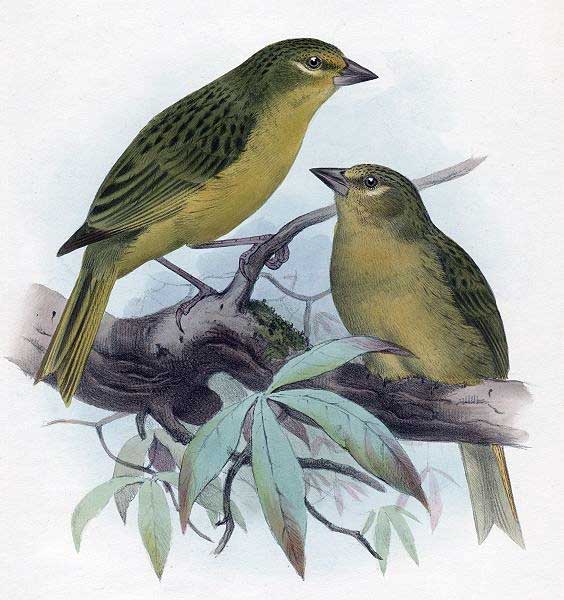
Nesospiza acunhae
Superregnum: Eukaryota
Regnum: Animalia
Subregnum: Eumetazoa
Cladus: Bilateria
Cladus: Nephrozoa
Superphylum: Deuterostomia
Phylum: Chordata
Cladus: Craniata
Subphylum: Vertebrata
Infraphylum: Gnathostomata
Superclassis: Tetrapoda
Cladus: Reptiliomorpha
Cladus: Amniota
Classis: Reptilia
Cladus: Eureptilia
Cladus: Romeriida
Subclassis: Diapsida
Cladus: Sauria
Infraclassis: Archosauromorpha
Cladus: Crurotarsi
Divisio: Archosauria
Subsectio: Ornithodira
Subtaxon: Dinosauromorpha
Cladus: Dinosauria
Ordo: Saurischia
Cladus: Theropoda
Cladus: Neotheropoda
Infraclassis: Aves
Ordo: Passeriformes
Subordo: Passeri
Infraordo: Passerida
Superfamilia: Passeroidea
Familia: Thraupidae
Genus: Nesospiza
Species: Nesospiza acunhae
Subspecies: N. a. acunhae – N. a. dunnei – N. a. fraseri
Name
Nesospiza acunhae Cabanis, 1873
Type locality: Tristan da Cunha
References
Cabanis, J. 1873. Protokoll der LII. Monats-Sitzung. In: Deustche ornithologische Gesellschaft in Berlin. Journal für Ornithologie 21 no.122: 152–155 BHL DOI: 10.1007/bf02252432 Reference page. First availability p. 154 BHL
Links
IUCN: Nesospiza acunhae (Vulnerable)
Vernacular names
English: Inaccessible Island finch
español: Yal de la Inaccesible
فارسی: سهره جزیره دستنیافتنی
suomi: Nightingalensirkku
français: Nésospize de Tristan da Cunha
Nederlands: Tristangors
polski: Tristanik mały
svenska: Tristanfink
The Inaccessible Island finch (Nesospiza acunhae), also known as the Inaccessible bunting, is a species of bird in the family Thraupidae (formerly in Emberizidae).[2]
It is endemic to Inaccessible Island of the Tristan da Cunha archipelago where its natural habitats are temperate shrubland and subantarctic grassland. It is threatened by habitat loss.
Taxonomy and systematics
The Inaccessible Island finch was previously considered two species, but the three subspecies are now grouped together.[2]
Subspecies
The subspecies of this species are:[2][3][4]
N. a. acunhae Cabanis, 1873. Found along the coastline, and has a small beak and drab olive-grey plumage, though the male is slightly brighter than the female.
N. a. dunnei Hagen, 1952. Found on the eastern edge of the island's plateau and the coastline, and has a large beak. It is larger than the other subspecies.
N. a. fraseri Ryan, 2008. Found on the Island's plateau at 300–600 meters (984–1969 feet), and has a small beak and bright yellow plumage. It has a large head long wings.
Description
It ranges from 17 to 21 centimeters (7 to 8 inches) in length and weighs 24 to 49 grams (0.8 to 1.7 ounces). All subspecies are some shade of olive-green. The call is a repeated series of three to four notes.[2]
Diet
The Inaccessible Island finch eats mainly seeds and insects. The plants consumed vary by subspecies. N. a. acunhae eats the seeds of Spartinia grasses, such as Spartina arundinacea, as well as Carex. N. a. fraseri feeds on Nertera. N.a. dunnei feeds on Phylica. All subspecies use flies as their main source of prey.[4]
Reproduction
It breeds from November to February. They are usually monogamous, and partners remain together for successive breeding attempts. Females lay one or two eggs in a cup nest close to the ground.[2]
References
BirdLife International 2004. Nesospiza acunhae. 2006 IUCN Red List of Threatened Species. Downloaded 26 July 2007.
Specific
BirdLife International (2016). "Nesospiza acunhae". IUCN Red List of Threatened Species. 2016: e.T22735943A95121524. doi:10.2305/IUCN.UK.2016-3.RLTS.T22735943A95121524.en. Retrieved 15 November 2021.
Sinclair, Ian; Ryan, Peter (2009). Complete Photographic Guide Birds of Southern Africa. Struik Nature.
"Inaccessible Finch (Nesospiza acunhae)". www.hbw.com. Retrieved 2018-02-21.
"Inaccessible Island Finch". www.oiseaux-birds.com. Retrieved 2018-02-21.
Retrieved from "http://en.wikipedia.org/"
All text is available under the terms of the GNU Free Documentation License

